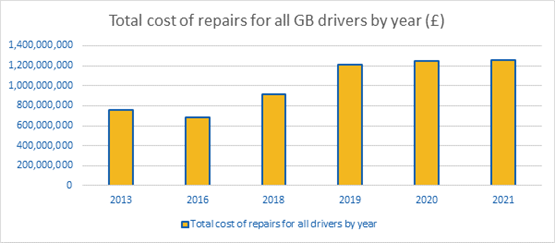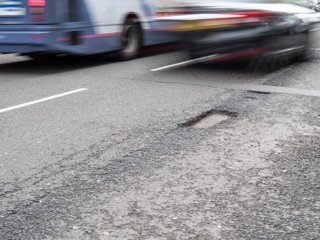The cost of repairs to vehicles suffering pothole damage over the past 12 months has been revealed in new research published by Kwik Fit.
Its annual Pothole Impact Tracker (PIT) report, which is published today (Wednesday, March 31), shows that the total repair bill to vehicles from pothole damage over the past year rose slightly, from £1.249bn to £1.267bn.
Kwik Fit’s PIT Report tracks the impact of potholes on an annual basis and its research shows that this year, despite reduced mileage, drivers have hit an average of 11 potholes per month, and some 10.2 million have suffered damage to their car as a result.
As tyres are a car’s first line of defence against potholes, they are the most commonly damaged component, suffered by 4.2 million drivers. This is followed by suspension damage (3m), wheels (2.8m) and steering (2m).
The average cost of repairs has reached £127.20, an increase of 11% on the previous year.

Almost half (48%) of drivers say that the condition of the road surfaces in their local area are worse than 12 months ago, with only 12% saying they are better; 35% say they are about the same.
Roger Griggs, communications director at Kwik Fit, said: “The condition of our roads is a long-term issue as shown by our PIT report over recent years.
“Potholes are not just an issue because of the cost to drivers, they present a risk to people’s safety.
“We need to ensure that any funds made available are used strategically and effectively and not just for short term patching up of the worst affected areas.”
The Kwik Fit research coincides with the publication of the Annual Local Authority Road Maintenance (ALARM) survey.
POTHOLE FILLED EVERY 19 SECONDS
It says that inconsistent roads funding is leading to highways authorities conducting quick fixes to potholes rather than employing longer-term solutions.
The 26th survey reports a 15% increase in highway maintenance budgets which were, in part, due to additional funding from central Government, including the Pothole Fund in England, as well as supplementary pots to support changes as a result of Covid-19 needs and active travel ambitions.
However, budgets reported are still lower than they were two years ago, and road conditions have yet to see any significant improvement.
This up-down approach to funding, says the Asphalt Industry Alliance (AIA), results in wasteful patch and mend repairs as local authorities have a statutory duty to maintain the highway but “don’t have the scope or certainty of funding” to implement more cost effective, proactive repairs.
This is borne out by the large increase in the number of potholes filled over the past 12 months in England and Wales, the equivalent of one being filled every 19 seconds, it says.
Local authorities also report that, despite the increase in budgets, target road conditions still remain out of reach.
If they had enough funds to meet their own targets conditions across all road types, there could be an additional 14,400 miles of local roads in a good state of repair and another 2,000 fewer miles in need of urgent repair.
Rick Green, chair of the AIA, said: “The last year has been like no other and the ‘hidden heroes’ responsible for maintaining our local roads should be proud of the role they played working throughout the pandemic to keep our key workers and emergency services moving, supermarket shelves stocked and vaccines distributed.
“While the extra funding in 2020/21 was welcomed, using it to repeatedly fill in potholes is essentially a failure as it does nothing to improve the resilience of the network.”
Green says that the average frequency of road surfacing is now once every 68 years and the bill to fix the backlog of maintenance work on our local roads in England and Wales remains in excess of £10bn.
“It is clear that a longer term approach to local road funding is needed, similar to the five-year commitment made to the strategic road network in the two Roads Investment Strategy (RIS) periods, to allow local authority highway engineers to plan ahead and implement a more proactive, sustainable and cost effective whole life approach to maintaining the network,” he said.
“This commitment is vital to the nation’s post-pandemic reset in which we will rely on our local road network to support recovery and underpin active travel and levelling-up goals.”
LONDONERS COMPLAIN MORE
The Kwik Fit research showed that drivers in Scotland are most likely to say their roads are worse than a year ago, while motorists in London are least likely.
In the capital a third of drivers 33% say the roads are worse, but nearly as many (27%) say they are better.
Interestingly, it is London drivers who are most likely to have complained to their local authority about the potholes in their area. Almost half (46%) of London motorists have done so, compared to an average of 30% of drivers across the country, which may be a reflection of the fact that London drivers pay an average repair bill of £142.60, compared to the national average figure of £127.20.
Drivers hitting potholes may find that the damage is not immediately apparent. Pothole impacts can often result in slow punctures, damage on the inside wall of the tyre, or cracks in the wheel which are not obvious straight away.
Any driver who hits a pothole with significant force should monitor their car carefully in the days following the incident, to ensure that their vehicle has remained unscathed.





















Login to comment
Comments
No comments have been made yet.